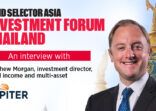Following the global financial crisis, multi-asset class funds gradually emerged as a popular investment vehicle because they can offset risk arising from market uncertainty and volatility. In turn, fund houses have been beefing up multi-asset capabilities and expanding product offerings.
As the name suggests, multi-asset funds use dynamic asset allocation strategies, diversifying across various asset classes with an aim to beat different market cycles, generate returns, and at the same time control downside risk.
With this as a theme, FSA takes a look at two of the well-known multi-assets funds from Schroders and JP Morgan Asset Management that are similar in their investment approach, investing into Asian equities and Asian fixed income securities and targeting income and capital growth.
The JP Morgan fund follows a flexible and dynamic asset allocation, maintaining equities and fixed income composition in the range of 25%-75%. Likewise, the Schroders fund has the mandate to deploy 30-70% of the corpus in Asian equities and similar allocation to Asian fixed income.
Performance review
Leonardo Drago, chief investment officer at Al Wealth Partners in Singapore, said: “In terms of two-year performance since May 2012, the JPM fund has outperformed the Schroders fund by approximately 2% per annum.
“However, taking a longer term view since mid-2011, the table turns and the Schroder fund has outperformed the JPM fund by approximately 2% per annum for the entire period.”
The differences in performance can be traced to specific periods during the funds’ history. Drago points out that from February to June 2012, the Schroder fund gained 4.35% while the JPM fund lost 2.07%.
Investment strategy review
Portfolio Managers
For the Schroder fund, Richard Coghlan, the head of multi-asset in Hong Kong, has the overall responsibility for the multi-asset portfolio team and overall responsibility of Schroder Asian multi-asset portfolios in Hong Kong, Singapore, Taiwan and Korea. Coghlan has been with Schroder since 2000 and has been managing the scheme since 2011.
Fees
The JP Morgan fund levies an initial fee of 5% of net assets and annual management and advisory fees of 1.5%. The Schroder fund, too, charges a 5% initial fee. The annual management charge is lower at 1.25% on A share class and 0.625% on C share class.
And the winner is….
Drago gives a slight edge to the JPMorgan fund.
“The main share class in Luxembourg has had a long track record since 2001. That can be used to better assess the longevity of the fund strategy as well as its performance during the 2001-2002 bear markets and in 2008.”
Drago likes JP Morgan’s overweight to China equities as he says it is the most undervalued equity market in the world and current valuations are at significant historical discount.
“Any future re-valuation of China equities should benefit JPM’s fund,” he added.

















